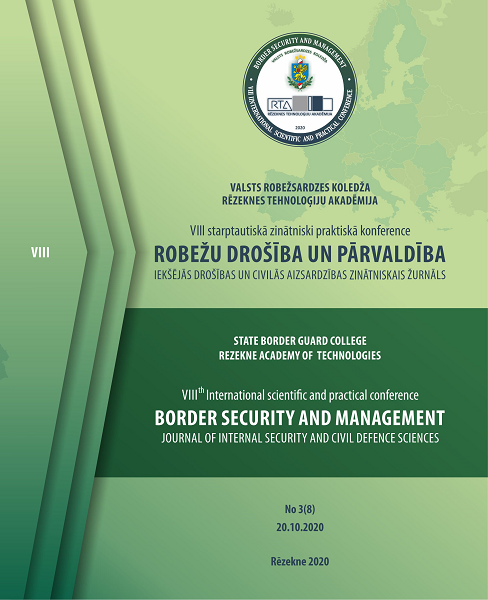ATTITUDES OF THE ESTONIAN BORDER GUARD AND POLICE OFFICERS ON IMMIGRATION AND RADICALIZATION
DOI:
https://doi.org/10.17770/bsm.v3i8.5360Keywords:
Asylum seekers, Border Guard Officers, cognitive dissonance, cognitive intelligence, CQ, Cultural Identity, Cultural intelligence, immigration, Internal Security, Islamic terrorists, language learning, lone-wolf, migration, open borders, Police Officers, political correctness, radicalization, Schengen Treaty, terrorists.Abstract
The article in the first part outlines the current discussion of the state of training under cultural intelligence, including definitions and examples of possible interdictions of the bad players. The second part describes the attributes and attitudes of Border Guard and Police officers after cultural intelligence courses, defining and applying the concepts towards internal security with a focus on Cultural Identity, “what makes a person tick.” An empirical study consisting of written reports was conducted over a three-year period and compiled to reflect attitudes towards immigration and radicalization in the EU.
References
ANG, S., & EARLEY, P.C. (2003). Cultural intelligence: Individual interactions across cultures. Stanford University Press
ANG, S., KOH, C., & VAN DYNE, L. (2006). Personality Correlates of the Four-Factor Model of Cultural Intelligence Article. Group & Organization Management 31(1), February, p. 100-123.
BRISLIN, R.W. (2001). Understanding Culture's Influence on Behavior (PSY 399 Introduction to Multicultural Psychology). 2nd edition, Wadsworth
CALLIMACHI, R. (2016). Attacks Expose a Struggle To Spot Future Terrorists. International New York Times. June 22.
DETTERMAN, D., & STERNBERG, R. (1986). What is intelligence? Contemporary viewpoints on its nature and definition. Norwood, NJ, Ablex
DU GAY, P., & HALL, S. (1996). Questions of cultural identity. Sage Publications, Inc.
EARLEY, P.C., & MOSAKOWSKI, E. (2004). Cultural Intelligence. Harvard Business Review, 82, p. 139-153.
FREUD, S. (1991). Group Psychology and the Analysis of the Ego. Civilization, Society and Religion. London, Penguin Books. Vol. 12, Penguin Freud Library, p. 91-178
HARRIS, S., ZAVADSKY, K., & ZADROZNY, B. (2016). House of Horrors – The unhinged home that raised Orlando killer Omar Matteen. Retrieved August 10, 2020, from https://www.thedailybeast.com/the-unhinged-home-that-raised-orlando-killer-omar-mateen
JAMES, P. (2015). Despite the Terrors of Typologies: The importance of Understanding Differences and Identities. Interventions: International Journal of Postcolonial Studies. Vol. 7 (2), p. 174–195.
MCLEOD, P. (2014). Cognitive Dissonance. Retrieved August 10, 2020, from https://www.simplypsychology.org/cognitive-dissonance.html
SIEGEL, J. (2016). The Daily Signal. June 23. Retrieved August 10, 2020, from https://www.dailysignal.com/






